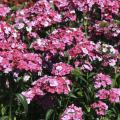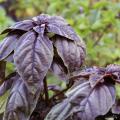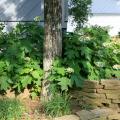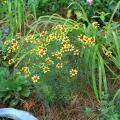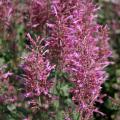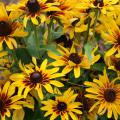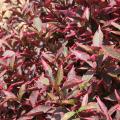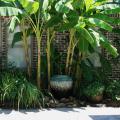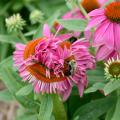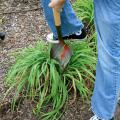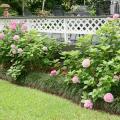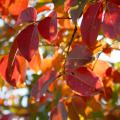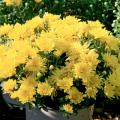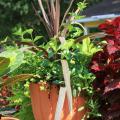Southern Gardening from 2011
Summer’s heat has descended suddenly, so you may not be considering planting dianthus, a group of flowering plants that typically thrive during the cooler months of the year.
They are called by many names, but the common name pink really is a good description. Colors include pink and red, and there are also attractive white and lavender selections.
For fresh summer recipes, nothing beats the taste of basil. Gardeners who want to grow basil for cooking can choose from a variety of colors, textures and flavors, making this herb a garden showpiece.
Basil is one of the easiest herbs to grow during the hot summer months. Most gardeners start with common, or sweet, basil, which comes in a wide range of leaf sizes and textures. Lettuce leaf basil has leaves as big as a man’s hand, and they are textured like lettuce. Try replacing traditional lettuce with a single leaf of it on a sandwich.
Hydrangeas are old-fashioned, rounded-form shrubs that put on flamboyant flower displays in the summer and fall. And every year, great new selections are introduced, so gardeners should watch out for these terrific new options.
The three types of hydrangea commonly found in Mississippi gardens are the French, the PeeGee and the Oakleaf.
French hydrangea has two types of flowers: mopheads and lacecaps. Mopheads resemble pom-poms and are big, round and showy. Lacecaps are fern-like.
To combat the dry conditions creating problems for home gardens and landscapes, many Mississippi gardeners need to water their plants a lot more than usual.
Generally, applying 1 to 1 1/2 inches of water per week using overhead sprinklers will leave the root zones of your plants moist enough to encourage optimum growth. This method of watering works for annuals and groundcovers, as well as perennials, shrubs, trees and lawns.
As we enter the hot part of the summer, I’m reminded of how much the cold of winter and the heat of summer have in common.
Before you dismiss me as crazy, let me explain how summer and winter can be similar. Due to the current heat and humidity, most Mississippi gardeners – including me -- are spending time indoors trying to avoid sunburn and heat stroke. This gives us a lot of time to think about what to plant and new gardening projects to accomplish when cooler temperatures return.
One of the most important factors in choosing flowering annuals is finding one that tolerates the hot Mississippi summers. Many annuals cannot maintain their color in the high temperatures, but the flowering Vinca is one that can.
Flowering Vinca is a versatile, full-sun plant. Known botanically as Catharanthus roseus, flowering Vinca originated in the hot and dry regions of southern Africa. It looks great mass-planted in the landscape or as a flowering ground cover.
With the temperatures heating up, many landscapers and gardeners are looking for plants that can stand up to the Mississippi summer. Luckily, they don’t have to look any farther than hot summer lantana.
When the heat makes gardeners want to stay indoors, it’s nice to have reliable, flowering plants that keep on looking good even when they don’t get a lot of attention.
The landscape performance of thread-leaf coreopsis, or Coreopsis verticillata, has made these plants outstanding choices for season-long color. And since it is an easy-to-grow, flowering perennial, beginner gardeners can have success almost immediately.
If I told you about a flowering plant that likes full sun, needs little water and thrives on neglect, wouldn’t you want to go out and buy one? Or several?
A plant with these requirements sounds perfect for our hot Mississippi gardens. Agastache (pronounced ag-ah-STAK-ee) may just be that plant. More commonly known as licorice mint, Mexican hyssop or hummingbird mint, this member of the mint family has -- as you may have already guessed -- a pleasing licorice aroma.
A favorite flower with almost every Southern gardener is the black-eyed Susan, known botanically as rudbeckia. These plants produce an abundance of bright yellow flowers, each with a dark button-shaped cone in the center.
There are several species for gardeners to choose from. Rudbeckia hirta is a Mississippi native wildflower and is a staple plant in naturalized areas and meadows. Black-eyed Susans are also reliable garden and landscape performers for the butterfly garden.
Gaillardia is a native plant with few pests that can liven up the summer landscape anywhere in Mississippi with its bright, warm colors.
Gaillardia makes a fantastic addition to the summer garden. Many gardeners know Gaillardia as blanket flower, a name that came from the early settlers’ comparing the colors of the flowers to those of the blankets of Native Americans. Gaillardia is named in honor of French botanist Gaillard de Charentonneau.
When gardeners want to add color to the landscape, they often reach for flowering annuals and perennials. While these colorful flowers always catch the eye, their selection is usually limited at this point of the summer.
Many gardeners never consider buying colorful foliage plants for anything but shady areas, but let me encourage you to reconsider their usefulness. These plants provide color, and you can still find good selections available in the local garden center that you can plant in the heat of summer.
A lot of gardeners are interested in creating a tropical feeling around their homes, and one of the easiest ways to do this is to add banana plants either in the landscape or in large containers.
If you’re about to quit reading because you think bananas can only be grown in coastal Mississippi and you live elsewhere, stick with me. I hope I can change your mind by describing some of the selections that are hardy for all landscapes in Mississippi.
Sometimes the most interesting plants in our landscapes are the ones that can’t be predicted. Each year, there is a wonderful, random variety that presents itself in the garden through the mutations that occur in every plant species.
The secret to finding some of these botanical gems is taking a closer look at flowering and evergreen plants. Every once in a while, we are rewarded with garden treasure.
A couple of years ago, I received a call in late summer from a new gardener asking about a plant he had seen at a local golf course. I was interested because he described it as a blue azalea. I visited the golf course and toured until I found the plant. It wasn’t a blue azalea after all, but the familiar Mexican petunia.
You don’t have to be a gardener for long before you come across a situation that calls for some garden “surgery” called division. Division is cutting the plant into smaller pieces and replanting.
You see the need for division when you notice a perennial plant no longer looking good. Maybe it hasn't been flowering prolifically, the leaves are getting smaller or the center is opening up. You decide to divide the plant to remedy the situation. Dividing perennial plants is a great way to rejuvenate some of our ornamental garden treasures.
Fall is the perfect time to start on your garden and landscape for next year. Amending the soil with quality, organic material is one of the best gifts you can give your garden soil.
There are quite a few options for gardeners when it comes to soil amendments. In Mississippi, many gardeners use cottonseed meal as an organic source of nutrients. It has a nitrogen-phosphorus-potassium analysis of 6-2-1 and is a good source of trace nutrients.
Fall has always been one of my favorite times of the year, something that probably has a lot to do with my growing up in Michigan, where I enjoyed cooler temperatures and trees changing colors.
Here in Mississippi, I enjoy waking up in the morning and feeling that chill in the air. I guess I am finally becoming acclimated because even 70 degrees feels chilly after a hot and humid Mississippi summer.
Just as the changing colors in nature signal the arrival of autumn, so do the appearance of beautiful, flowering mums at our local garden centers.
Adding fall mums, which is the short name for Chrysanthemums, is a stress-free way to provide color to the fall landscape. It’s easy to see why, as these plants will produce more flowers than you could possibly count. The selection of colors seems limitless, from rustic earth tones to bright and cheery pastels.
Available sizes range from 4-inch pots all the way up to 5-gallon containers and bigger.
The gorgeous colors we are seeing in nature this fall can be repeated in our landscapes with fall combination containers. The warm colors of red, orange, and yellow all add excitement to the cool temperatures.
Creating your own fall combination containers is easy if you follow the thriller, filler and spiller formula. Don’t limit yourself on plant selection -- use annuals, perennials and even tropical houseplants. When cold temperatures are forecast, these combination containers will also look good inside.

